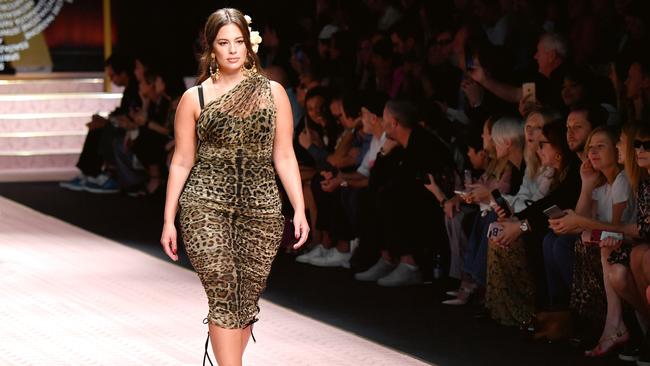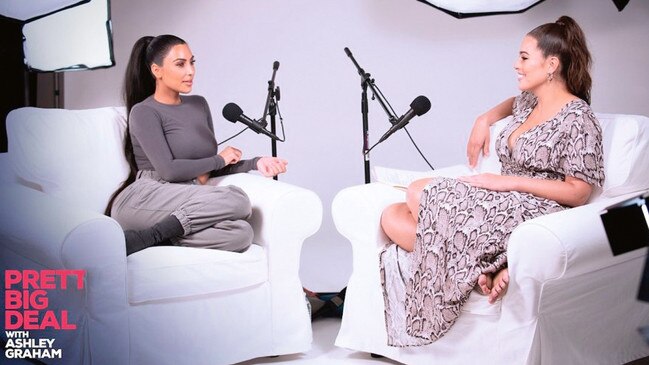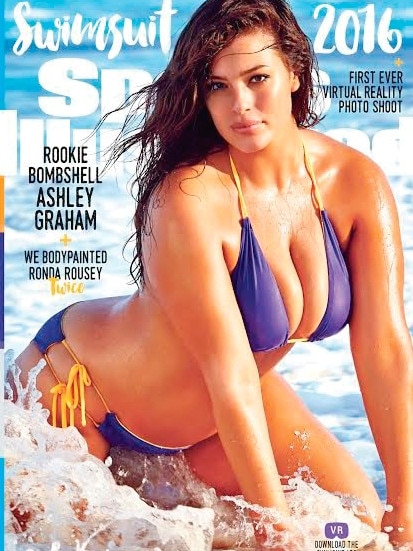‘They told me to put the Snickers down’
She is one of the highest-paid models in the world, but as a teenager trying to land modelling jobs, body activist Ashley Graham reveals how she was constantly ordered to lose weight.
Stellar
Don't miss out on the headlines from Stellar. Followed categories will be added to My News.
- Dr Chris Brown: ‘I’m certainly looking for the one’
- Margaret Cunneen: ‘If you want to assassinate me, don’t miss’
Twelve years ago, the world was not ready for Ashley Graham.
At a time when fashion magazines and runways were still dominated by the quintessential ’90s waif Kate Moss, Graham — an aspiring model aged 19 — was regularly called ugly and fat. To her face.
She was begged, cajoled and ordered by agents to lose weight. One offered her cash to diet, another told her more than once to “put the Snickers down”.
Despite having been scouted in a suburban American shopping mall aged just 12 and signed by the prestigious Ford modelling agency at 15, the consensus was clear: Graham seemed destined for a career modelling catalogues for “plus-size” brands.

“I had been picked apart and manipulated by agents and photographers and models,” Graham tells Stellar of those early years. “I was never good enough, or skinny enough or tall enough.”
As a consequence of the pressure, she started drinking and taking drugs, sleeping with “half of New York City”, as she later put it, and steadily gaining weight until she peaked at an Australian size 22.
After all, this was a girl who had grown up not caring about fashion or agonising over her appearance — in fact, when it came to career goals, she dreamed only of being Oprah.
“Struggling with who I was as a person” and certain her attempt to become a successful model was over, one day — about two years after moving to New York — a defeated Graham called her mother back in Nebraska and announced that she was coming home.
“And she said, ‘No you’re not, your body is going to change someone’s life,’” Graham recalls of that fateful phone call.
“I have no idea why, and she could not have known how at the time”, she says, “but here’s the thing — mothers instinctively know what to say and when to say it and looking back, it was kind of prophetic.”

To say the least. After a lifestyle reset, Graham slowly began to notch up one job after another — “mild successes every year, but always something that kept me pumped up” — a show, an ad campaign and eventually, a magazine or two.
Around the same time, she met a videographer named Justin Ervin at church. She married him when she was 22, and credits their partnership as a major influence on her career trajectory from that point on.
“It would have been immensely different without him,” she says. “Night after night I would be up crying because I felt like I made the wrong move, or couldn’t figure out what to do, and he was there, even in the beginning, a right-hand man. I hate to use the word, but I feel so blessed that he’s there. He has made me a better woman.”
Now, at age 31, she’s certainly a famous one. She has become one of the most highly paid supermodels in the world, earning an estimated $7 million a year from a combination of editorial and runway work.
She’s ticked off the covers of British, American and Italian Vogue, as well as ELLE and Harper’s Bazaar — her look frequently described as part Cindy Crawford and part Eva Mendes.
But even if she has taken her place in the fashion stratosphere, by industry standards Graham is “plus size”.

For all her achievements, including the cover of the Sports Illustrated swimsuit issue in 2016, the focus remains squarely on Graham’s atypical measurements — her 36DDD bust, her full hips, thighs and flesh that one British journalist breathlessly described as being “as ripe and firm and plump as a mango”.
Other depictions have been less charitable, meaning that all these years later, it can feel like the world still doesn’t know where to place her.
In British Vogue in 2017 a respected industry journalist, who confessed upfront to “worshiping at the shrine of skinny”, called Graham a “big girl” with back fat, “shot-put thighs” and visible cellulite, although conceded that because of her 175cm frame and hourglass waist, Graham doesn’t necessarily “look fat”.
In truth, what she looks like is simply far closer in size to the average Australian woman (who wears a size 14) than most models.
“We still have a very long way to go,” says Graham, who is clearly rankled by the “plus-size” label.
In fact, it was not so long ago that Graham would appear on a runway to audible gasps of shock.
Not so much anymore — Australians can get a front-row seat and see for themselves at next month’s annual Virgin Australia Melbourne Fashion Festival.
In a few weeks Graham will travel to Australia for the first time and deploy her million-dollar figure for Runway 4 on March 7, ahead of speaking at the Australian Fashion Summit a day later.

The topic for discussion is “the new normal” and guests can expect to hear Graham call out what’s no longer tolerable for consumers, champion diversity and discuss changing perceptions within the fashion industry.
“You can achieve anything when you stop putting limitations on yourself and start envisioning greatness,” Graham tells Stellar. “I’ve looked up to the supermodels of the ’80s and ’90s, following their careers into the early stages of mine. I saw these women as more than models, but moguls with the ability to influence and make change.
“I hope that my work and mission inspires a new generation of women leaders, encouraging brands to do the same. I want to see more brands recognising and celebrating their customers.”
She describes herself as a body activist, but admits she’s not sure if being a role model for body positivity is something that she consciously took on, or had foisted upon her.
“I hadn’t heard of any models talking about themselves as a body activist when I started calling myself that,” she says. “It was time that someone stood up and started demanding the change we want in the industry.”

It’s common, when anyone atypical appears on a magazine cover or in a movie, for their inclusion to be deemed “token”, a cynical effort by decision-makers to make a brand look in tune with the zeitgeist. But Graham is not bothered by such labels.
“There is tokenism, I understand that,” she says. “However I don’t necessarily think it’s a bad way to create change. If it never breaks a barrier, sure, but right now we’re in this massive moment of change, in terms of what’s been the norm for so long. The important thing is that we continue to talk about curvy girls, about gender, race, whatever it is.”
Instagram is by far her most powerful tool, and she’s mindful of the responsibility that comes from having eight million followers.
MORE STELLAR:
The real-life ‘M’ from James Bond
Do New Year’s resolutions ever work?
Models, pre-internet, were mostly seen and not heard but “social has given me an automatic voice and because of that I need to be responsible with it. And Instagram is positive when you use it authentically, right?” she says, explaining why she so happily posts pictures of a dimpled thigh, a rounded belly or an unmade-up face as often as a flawless modelling shot from her magazine work.
“When I was growing up I didn’t ever have role models who looked like me but now, you type hashtag body positivity and there you are. I get so much praise for the un-retouched photos where you can really see who I am.”
And she’s had some high-profile support from one of Australia’s biggest modelling exports in Elle Macpherson.
“Elle and I met backstage at my Sports Illustrated swimsuit cover-reveal TV special, and she told me she was rooting for me to be on the cover. Imagine ‘The Body’ complimenting your body — it was epic!”

Away from the often frivolous confines of social media, Graham has gone on to address the UN Leadership Summit, written a memoir, recorded a TEDx talk on the size debate that has been viewed almost three million times and added her voice and influence to public discourse around feminism.
On her podcast Pretty Big Deal, she even extracted an apology from Kim Kardashian West over an Instagram post that was criticised for being seen to glorify anorexia.
In July last year Kardashian West shared videos to Instagram in which her sisters complimented her figure, describing her waist as “anorexic”. In Graham’s October podcast, a contrite Kardashian West conceded she should have “known better”.
But for Graham personally, a seminal moment came late last year, with a multi-page spread for Vogue Paris wherein no mention was made of her size.
“I wasn’t being looked at as curvy,” she says. “It was just about beautiful images. And that’s the way it should be.”
The Virgin Australia Melbourne Fashion Festival will take place from March 1 to 10. For tickets, visit vamff.com.au.
READ MORE EXCLUSIVES FROM STELLAR.
Originally published as ‘They told me to put the Snickers down’


